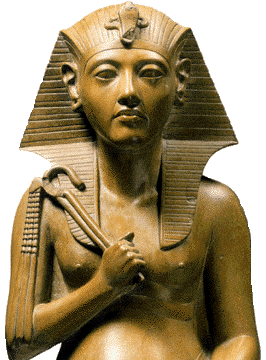Akhenaten - The Glory of the Aten

|
There have been theories that Akhenaten shared the throne with his father Amenhotep III for a time. After his father's death, however, he initiated drastic changes in his state. First, he built a temple on the perimeter of the famous Temple of Amun at Karnak during the first year of his reign, dedicated to Aten, rather than Amun (the principal deity at the time). Originally Amenhotep IV ('Amun is content'), he changed his name to Akhenaten ('glory of the Aten') in the sixth year of his reign. He erased the names of other gods, particularily Amun, and even expunged the plural 'gods' from the language. He also erased his father's name wherever he found it. Akhenaten then relocated the capital to Akhet-Aten, where palaces and buildings were swiftly built from mud brick, and in which he built a splendid temple to the Aten filled with religious art. |
| Akhenaten apparently neglected foreign policy, allowing Egypt's captured territories to be taken back, though it seems likely that this image can be partially explained by the iconography of the time, which downplayed his role as warrior. Akhenaten ruled for eighteen years, to be succeeded by 'Smenkhkara,' believed by some to be Nefertiti herself, and soon afterwards by Tutankhaten, who quickly changed his name to Tutankhamun, and whom we all know well as 'King Tut' after his tomb was discovered intact. The new city was abandoned, and worship of the Amun was reestablished. The story of Akhenaten and his name itself was erased efficiently from Egyptian history, and he was referred to as 'that heretic' or 'rebel' if necessary. |
|
An intriguing mystery remains about the bodies of Akhenaten and
his family. Though he did begin building a royal tomb, it appears
to have been left unfinished, and only one of Akhenaten's daughters
was buried there, Meketaten. One scholar (Theodore Davis, 1907)
discovered a mummy believed to be Akhenaten, lying with funerary
equipment of Queen Tiy in the Valley of
the Kings, but more recent hypotheses suggest it is not. To further
the mystery, it has been suggested it belongs to Smenkhkara, the
mystery successor of the Pharaoh. The identification of Akhenaten's
mummy would be of interest to the medical community too. Due
to the very distinctive style of portrayal of the Pharaoh in the
art of the time, it has been suggested that
Akhenaten had Marfan's
Syndrome. Find out more at our Web Links: Akhenaten. |
![]()
|
|
This page is part of The
Akhet-Aten Home Page |
